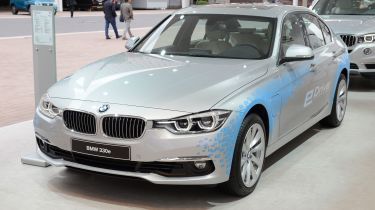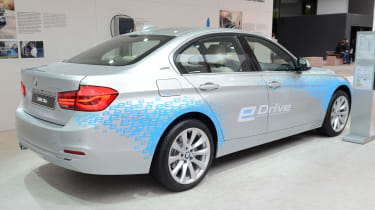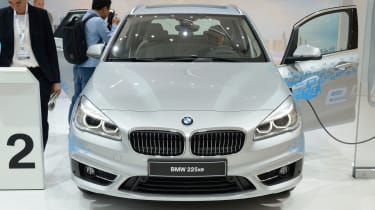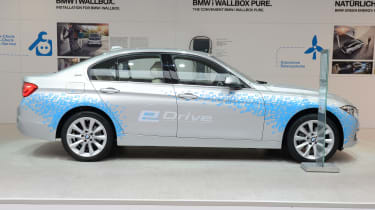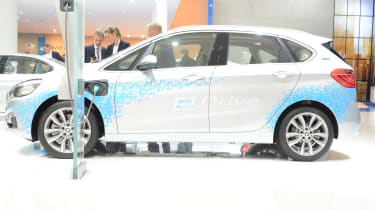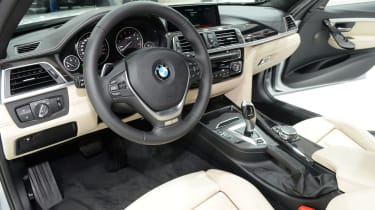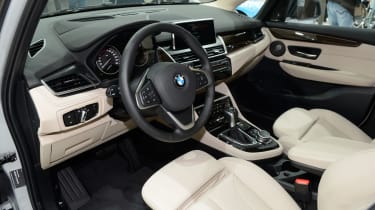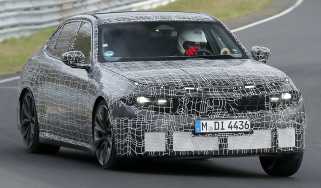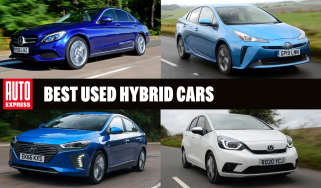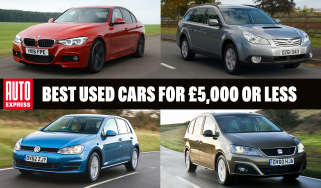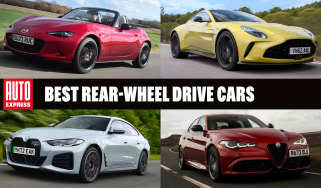BMW 330e and 225xe plug-in: UK prices revealed
BMW's new 2-Series Active Tourer and 3-Series plug-in hybrid range priced from £35,005 and £33,935 respectively
After their debut at the 2015 Frankfurt Motor Show, BMW has revealed pricing for its two new plug-in hybrid models, the 330e and 225xe. The petrol-electric 3-Series is on sale now, while the 2-Series Active Tourer will be available from March.
The 330e starts from £33,935 in SE trim and is available in all other trims in the 3-Series range. It also remains a dedicated rear-wheel drive sports saloon. The £35,005 225xe, on the other hand, is a standalone model that previews one of the key powertrains planned for the X1 and for the upcoming X2.
The 225xe takes its powertrain inspiration from BMW’s bravest shape, the i8, effectively taking its combination of electric and petrol motors and turning them around.
As previewed in a prototype drive in France a couple of months ago, the 225xe will feature a 1.5-litre, three-cylinder turbocharged petrol engine powering the front wheels and a shrunken version of the i3’s electric motor driving the rear wheels.
The system gives the 225xe effective on-demand all-wheel drive. Combined, the two power plants give the 225xe the ability to sprint to 62mph in a respectable 6.7 seconds and reach a top end of 126mph. On the flip side, it pumps out CO2 emissions of just 46g/km.
It can drive on pure electric power at speeds of up to 77mph, while it posts an official EU pure-electric range figure of 25 miles from a fully charged lithium-ion battery.
The five-door, five-seater tips in at 1660kg – a full 150kg more than the 225i xDrive thanks to its extra battery, gearbox, electronic control unit and electric motor.
The car boasts a system output of 165kW of power and 385Nm of torque, with 100kW and 200Nm of that coming via the three-cylinder, direct-injection turbo motor and channeled through a six-speed automatic transmission. There’s also a 15kW generator, which acts as the car’s front-end electric harvester and its starter motor, as well as adding its own power to the gearbox under hard acceleration in Sport mode.
At the back there’s a 7.7kW/h lithium-ion battery sitting beneath one side of the rear seat and a 36-litre petrol tank beneath the other side (and it’s metal rather than plastic, to manage the probability that it could remain full and untapped for months on end).
The 65kW/165Nm electric motor sits in a transaxle package behind the rear axle with own two-speed transmission. There’s also a generator (for harvesting braking energy) and the new control electronics. It’s a smaller, more compact motor than even the one in the i3.
It’s effectively a rear-wheel drive car when the car is running in its pure electric mode, punching through the two-speed transmission. When it’s in Charge or Hold modes, it’s a front-wheel drive car running through the six-speed transmission and when it’s in Sport mode, it’s all cogs on deck.
Its Samsung batteries help it to operate as an electric car at speeds of up to 78mph in both EcoPro and in the electric eDrive modes, though the default hybrid mode switches the electric motor off at 53mph because it’s more efficient at speed as a petrol-powered machine.
It also has 400 litres of luggage space, losing a chunk to its new under-floor tenants, though it can still pack in 1,350 litres with the rear seats folded down.
The other car that’s had the zap treatment is now the cleanest 3 Series money can buy, which doesn’t mean it’s slow.
BMW still claims a 0-62mph time of 6.1 seconds for the 330e, along with a 140mph top speed, and 44g/km of CO2.
Unlike its little 225xe stablemate, though, the 330e isn’t an all-wheel drive plug-in hybrid. It’s a dedicated rear-wheel drive car, all the time.
Like the 225xe, it starts as a pure electric car, with the hybrid Auto eDrive as the default mode and sticking with battery power alone at up to 50mph. There’s also Max eDrive, which lifts the top electrically powered speed to 75mph and delivers around 25 miles of emission-free range. There’s a mode to save your battery power to run on petrol power alone (on a motorway leading to a city, for example).
The 330e combines a TwinPower 2.0-litre, four-cylinder turbocharged petrol motor with a synchronous electric motor wedged inside the eight-speed automatic transmission.
Itself a high-tech device, the 2.0-litre four boasts a twin-scroll turbocharger, direct fuel injection, variable valve timing and lift and a host of other trick features. They’re enough to deliver it 181bhp between 5,000 and 6,500rpm, plus 290Nm of torque, which peaks at just 1,350rpm.
The electric motor, which also acts as a generator when the car is recuperating energy when it’s stopping or slowing down, has 65kW of its own to contribute, plus its 250Nm of torque, which is available instantly.
Adding them together is good for 248bhp of system power and 420Nm of torque, according to BMW, and using them in hybrid mode delivers a fuel range of around 370 miles. It also takes just over two hours to recharge, according to BMW, but only if you have a 3.7kW wallbox charger (16 Amps and 230 Volts). It’s more than three hours from a domestic power point.
The hybrid nature of the powertrain means BMW only gives the 330e a 41-litre fuel tank, which is made from steel to cater for long periods between refills.
The car’s dimensions remain the same over other 3 Series models but what it doesn’t retain is the luggage capacity, which shrinks down to just 370 litres, largely due to the packaging demands of the battery raising the height of the boot floor. It also has a 40:20:40 layout for the folding rear seat.
Now read our first drive reviews of the BMW 330e and BMW 225xe...
Find a car with the experts
